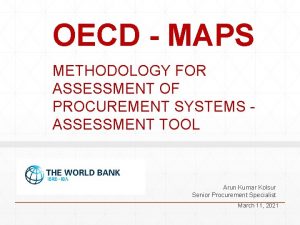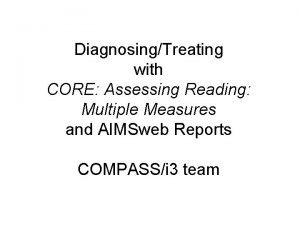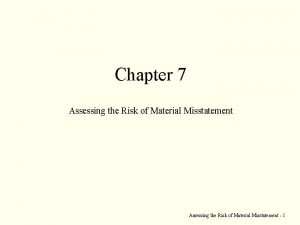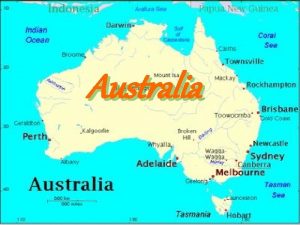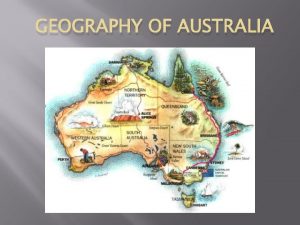Assessing Innovation Systems in Australia Don ScottKemmis Innovation



















- Slides: 19

Assessing Innovation Systems in Australia Don Scott-Kemmis Innovation Management and Policy Program National Graduate School of Management Australian National University

Evolution of Innovation Systems l l NIS a useful concept but not yet a strong framework for analysis and evaluation Innovation systems approaches challenging to apply in Australia – fragmentation, international links. Systemic failure can be a driver of evolution Analysing how innovation systems evolve and respond to failure should give insight into the NIS

The Laggard Perspective on Australia High dependence on natural resources- 80% of the top fifteen export products are resource-based commodities with a low level of processing Failing to develop new areas of specialisation and growth Productivity growth in the 90's the result of one-offs: micro-economic & ICT Weaknesses in new firm formation The poor performance in R&D and patenting signals the weaknesses in management, scale and international positioning of Australian industry. Declining position in many ‘high tech’ sectors indicates the extent to which Australia is being left behind the frontier of innovation and growth- Large and growing trade deficit in ICT products and services One of the lowest in the OECD in – – – BERD investment in venture capital; International patenting activity (per mill. Population)

The Boom Perspective on Australia A broadly based dynamic and flexible economy, diversified across markets, and increasingly sectors, underpinned by competitive domestic markets and flexible labour markets. High-level human resources and strong research organisations facilitate the rapid uptake of new knowledge produced anywhere. Imported knowledge and equipment combined with local knowledge and capability supports active problem solving and systems integration in a range of sectors generating relatively high levels of productivity. A ‘fast-user’ strategy combined with natural and human resources is a sound basis for future prosperity. l l l High and increasing productivity; Relatively high level of public sector R&D; Substantial growth in niches markets in key manufacturing sectors: automobiles and components, wine, boats. Maintaining strong competitiveness in resources sectors through the effective application of new technology, including IT; A strong ICT services sector and high growth in ‘knowledge based services’; Rapid and broadly-based uptake of new ICT.

Characteristics of Australian Innovation-1 Knowledge Based Resource Industries Conservative Evolution Scientific strengths – Technological specialisation – Patenting behaviour – Specialisation in export products –

Changes in ‘revealed comparative advantage’ in Australian scientific publications output in four periods


Science Linkage vs. Technology Cycle Time (1980 -2001)

Characteristics of Australian Innovation-2 Systems Integration Plus l l No core technology production Problem solving – but sophisticated Technology mobilisation for resource based industries and services ICT diffusion through the innovation system

Australia – major R&D fields of technological skills (RF), 2000– 01 (% of GDP)

Approach to Analysis: Looking at Change. Sectoral Approach– more or less! Building Blocks q Actors and Networks: interaction, competences q Knowledge Bases: appropriation, acquisition, increasing returns q Institutions: coordination, incentives, ‘rules of the game’, standards. q Technological structure Problem solving

Innovation System Evolution Phases Techno-economic opportunity Emergence Techno-economic problem Growth Renovation

Different Stages Need Different Assessment Frameworks Key Challenge Emergence Techno-econ insight Firm building Establishing a trajectory Growth Driver Locus of action Vision, Opportunity Champions Entrepreneur Virtuous circle, Increasing returns, System building Specialisation Institutional complem’y Complementarities problems Renovation Addressing systemic failures Unpackaging the paradigm Systemic failures Crises Entrepreneur, Manager, Kn & info transfer Organisations Entrepreneur, Manager, collaboration Ext. actors

A Possible Approach to Functions in the Evolution of Innovation Systems Resource supply Incentives to innovate Identify Problems Recognise the potential for growth Facilitate Kn & Info Exchange Guide Search Create new Knowledge Stimulate/ create markets Reduce social uncertainty Selection Counteract resistance to change Based on Johnson, 2001

A Possible Approach to an Innovation Systems Failure Framework Actors – missing actors Demand Compan’s Kn. Org’ns Third Parties Govern’ce Weak Strong ‘Rules’: System failures Infrastructural failures: Hard: Institut’l Soft: failure Interact’n failure Capabilities failure

Systemic Problems and Responses in the Evolution of the Wine Industry 1960 s Excess capacity Knowledge Base Actors & Interaction Institutions major corpns brings prof’l mngmt Dev’t of export market Kn. Old family companies Growth of large local wine companies Breaking out of the euro paradigm 1970 Developing the robust product design and the ‘system’ Kn. Based prod’n Specialisation in all aspects rural R&D framework. industry associations effective collective action & lobbying Export standards Industry ‘visions’ 1980 -2000 Rapid growth Strong kn. base in major firms Kn. sharing. use of int’l Kn. new analytical techniques Strong networking Strong training organisations Increasing scale specialist service providers vocational training. Consolidation of the institutional framework.

Systemic Problems and Responses in the Evolution of Minerals Exploration Focusing search Resourcing innovation Knowledge Base Actors & Interaction Institutions Development of new tools for Australia Localised kn. of geology survey agencies- survey & store data Government funded pre -exploration surveys Sophisticated capital markets for financing exploration collaborative development of tools exploration permit system Data standards (JORC) mandatory info sharing Taxation and share market risk funding. Native title Specialisation in exploration Specialisation in risk Public sector R&D for tools & kn frameworks. Bridging organisations Collab’n for new innov’n Funding of collaborative programs Major firms more global Knowledge New tools need a new acquisition & kn base assessment New tools for visualisation

Emerging Photovoltaic Innovation Systems Increasing returns Institutional Alignment Standard’n and Reuse of knowledge System Failures (examples) Lack of economies of scale Ad-hoc policies lack of political & social legitimation Low level of subsides and incentives Excellent science base but policies have limited the level of experimentation Relevant but fragmented knowledge base -mainly exploited by overseas innovation systems Much of the RAPS based knowledge cannot be applied to urban systems Lack of industrial actors with resources to bring technology to mass -production Level of incentives to attract large firms Lack of a national climate for supporting renewable energy

Focus and Change l Specialisation and Coordination -organisations and institutions for bridging, collaboration, coordination l l Local problem solving and global search Focus and Diversity -Co-evolution of supply and demand, -Broad kn & education base ensuring diversity for perceptions of problems & opportunities, initiating new trajectories problem solving, renovation of knowledge bases
 Oecd maps
Oecd maps Mysite socccd
Mysite socccd Radical vs disruptive innovation
Radical vs disruptive innovation To take something that doesn't belong to you
To take something that doesn't belong to you Btec sport level 3 unit 3
Btec sport level 3 unit 3 Unit 18 assessing children's development support needs p1
Unit 18 assessing children's development support needs p1 Teaching and assessing grammar in the writing classroom
Teaching and assessing grammar in the writing classroom Curriculum domain
Curriculum domain Task analysis in hrd
Task analysis in hrd Advantages of informal assessment
Advantages of informal assessment Manual for assessing safety hardware
Manual for assessing safety hardware Cultural dynamics in assessing global markets
Cultural dynamics in assessing global markets Assessing a new venture's financial strength and viability
Assessing a new venture's financial strength and viability Assessing cardiorespiratory fitness
Assessing cardiorespiratory fitness Assessing leadership and measuring its effects
Assessing leadership and measuring its effects Module 4 topic 5 turnabouts and parking
Module 4 topic 5 turnabouts and parking Module 4 topic 1 assessing and managing risk
Module 4 topic 1 assessing and managing risk A nine box matrix requires assessing employees on ________.
A nine box matrix requires assessing employees on ________. Core assessing reading multiple measures
Core assessing reading multiple measures Acceptable audit risk
Acceptable audit risk
